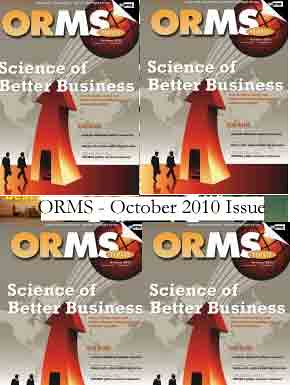 Can Math help improve HR mandates in an organization? This was a question I posed to Atanu Basu while I was interviewing him for a blog post I was doing on Predictive Analytics for HR. Atanu is the CEO of DataInfoCom who have been working on solving a bunch of business problems for companies like Dell and Microsoft. DataInfoCom, is an analytics software company headquartered in Austin, Texas. They recently won an “emerging technology” investment award from the Texas Governor’s office. Atanu and I have been talking about potential opportunities for building Predictive HR.Recently the Operations Research and Management Sciences Today magazine in their October 2010 issue printed the article Atanu and I co-authored on possible opportunities for using Predictive Analytics for four major areas of HR – Recruitment, Attrition & Loyalty, Learning & Development & Talent Management. Here is the article that appeared in the October 2010 issue of ORMS Today magazine.—————-Listen randomly to ten interviews of Global Fortune 500 CEO’s and you will hear them mention “it is all about the people” in the company. HR professionals have the important mandate of making a business successful by acquiring, engaging, and developing talent. While some corporations are legendary for their people practices – GE and PepsiCo come to mind – most companies still go about the business of talent acquisition, retention, and development the same way they did in the past. While there has been intent, in the absence of the appropriate tools, HR and business leaders have found it challenging to deliver on the HR agenda. Predictive Analytics and related technologies have the ability to transform HR as we know it. We started exploring this area over a year ago.Let’s look at the HR mandates and explore how predictive decisions can deliver business value.
Can Math help improve HR mandates in an organization? This was a question I posed to Atanu Basu while I was interviewing him for a blog post I was doing on Predictive Analytics for HR. Atanu is the CEO of DataInfoCom who have been working on solving a bunch of business problems for companies like Dell and Microsoft. DataInfoCom, is an analytics software company headquartered in Austin, Texas. They recently won an “emerging technology” investment award from the Texas Governor’s office. Atanu and I have been talking about potential opportunities for building Predictive HR.Recently the Operations Research and Management Sciences Today magazine in their October 2010 issue printed the article Atanu and I co-authored on possible opportunities for using Predictive Analytics for four major areas of HR – Recruitment, Attrition & Loyalty, Learning & Development & Talent Management. Here is the article that appeared in the October 2010 issue of ORMS Today magazine.—————-Listen randomly to ten interviews of Global Fortune 500 CEO’s and you will hear them mention “it is all about the people” in the company. HR professionals have the important mandate of making a business successful by acquiring, engaging, and developing talent. While some corporations are legendary for their people practices – GE and PepsiCo come to mind – most companies still go about the business of talent acquisition, retention, and development the same way they did in the past. While there has been intent, in the absence of the appropriate tools, HR and business leaders have found it challenging to deliver on the HR agenda. Predictive Analytics and related technologies have the ability to transform HR as we know it. We started exploring this area over a year ago.Let’s look at the HR mandates and explore how predictive decisions can deliver business value.
Recruitment
In a Harvard Business Review study, Ram Charan showed that two out of five new CEOs fail during their first eighteen months. The essence of successful hiring at any level is to find someone who is willing, able, and qualified for the vacancy. Traditionally, when we come across an interested candidate, we collect the pertinent data and make the best possible judgment call. Examples of collected data include requirements for the role, candidate’s qualifications, past performance, interactions during the interview process, and reference checks. In today’s dynamic business climate, we can’t rely only on past performance, and limited interactions during the interviews, to predict future performance of a candidate.What if we have to choose one from a pool of ten similar candidates, which one of these ten has the greatest likelihood to succeed in the role? Once hired, how long will it take this person to succeed, assuming the success metrics for the role are clearly defined, and how successful would she be? If HR acquires the ability to predict – to identify, quantify, and rank – the future performance of a candidate before making a hiring decision, it would be a great value addition to the business. Enter predictive analytics. By taking into account datasets that are intuitively obvious – resumes, job descriptions, references, and interviews – and some that may not be so obvious, mathematical algorithms can be used to answer questions about the future. These algorithms can also unearth predictors of success (in a role) that may not have been considered before, thus improving the entire recruiting process.
Attrition & Loyalty
Gone are the days when employees worked for decades for the same corporation. Today’s businesses have learned to live with employee churn, while evolving to minimize the impact of attrition on the overall health of the business. Attrition at all levels remains an issue that corporations would like to understand and get ahead of. While some businesses, such as insurance sales and business process outsourcing, are known for their high attrition, many other businesses also suffer regularly from attrition, especially in key leadership roles.Who is going to leave, when? Why? Where is she going to go? How can we keep her? Is she worth keeping this way? HR needs predictions, and decisions to take advantage of these predictions. Once the appropriate datasets, business rules, etc. are gathered, predictive analytics can answer the what, when, and why questions and operations research can answer the how and what-if questions for HR. The continuous learning that will follow, once these algorithms are in place, will help managers identify and quantify the leading indicators of attrition for their employees, plus help managers take preemptive actions to retain their human assets. Loyalty is the flip side of this coin. Similar methodologies can enable forward looking decisions with respect to: Which incentives – and it doesn’t always have to be money – will generate loyalty from which employee and for how long. And so on.
Learning & Development
This part of the organization kicks in to bridge the capability gaps that the recruiting team is not able to close. What if we could predict, which competencies would be easiest to learn – and which developmental approach would be the most effective – for which employee? Which training, if any, would be able to fill in the experience gap for an employee who is otherwise-qualified for her next assignment? People develop their skills from a variety of experiences, interactions, and relationships. Formal development plans try to shorten the time needed for developing these competencies. Predictive decisions would help us customize this methodology per employee per competency gap. So the Individual Development Plan for Employee A would not only state that the development gap for Employee A is Decision Making, it will also suggest having Employee X mentor A because that is the most effective mentor-mentee relationship for this particular skill. The Plan may go on to say that Employee A should, however, learn about building Financial Acumen by watching a video tutorial. Dell used predictive training to increase the effective tenure of new call center agents so they can deliver better customer experience to the callers.
Talent Management
Many organizations that have a formal approach towards talent identification use a performance vs. potential matrix by classifying their employees into high-medium-low performers and with high-medium-low potential. The assumption is that past performance is an accurate predictor of success in future roles. To assist in potential identification, the companies use assessment centers to simulate scenarios that determine success in the next role. In a world that is rapidly changing, the assumptions about future roles that do not keep pace with the external shifts are not going to predict which employee to bet on. What if someone is a poor performer in the current role but has the competencies necessary for the next role, especially if the two roles demand different competencies? Most succession planning processes today assume that a trend of strong performance is the best predictor of success in a future role, no matter how different the past roles are from the future role. Adaptive algorithms that produce updated predictions, and associated decisions, as more (and better) data becomes available can help. The US Army is already using information from aptitude tests, medical tests, etc. to place applicants in the type of career path best suited for their skills and interests.
Is Predictive HR necessary?
Mistakes in people decisions can be costly for the business. Being successful in HR is about making correct decisions about critical people matters. Any foresight before making a people decision – be it in recruitment, retention, development, or succession planning – is a powerful weapon in HR’s armor. Do predictive decisions guarantee success for HR? No. However, studies show that most of us can’t intelligently process more than eight variables at a time. Predictors that humans come up with inherently embed some kind of a cause and effect relationship – our brains are just not equipped to identify and quantify predictors that may not have cause and effect synergy. On the other hand, advancements in mathematical sciences and computer science have enabled algorithms to take into account thousands of related and unrelated data points – numerical, text, audio, video, etc. – and business rules, process them computationally, and come up best possible future decisions. Far more than human judgment and traditional methods can do.Atanu can be reached at abasu@datainfocom.com.Source: Operations Research and Management Science October 2010 http://bit.ly/9I3ds6********************If you want to read more about What is Predictive Analytics, read this article here


Leave a Reply